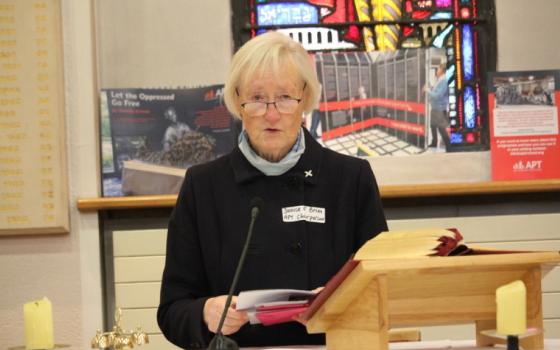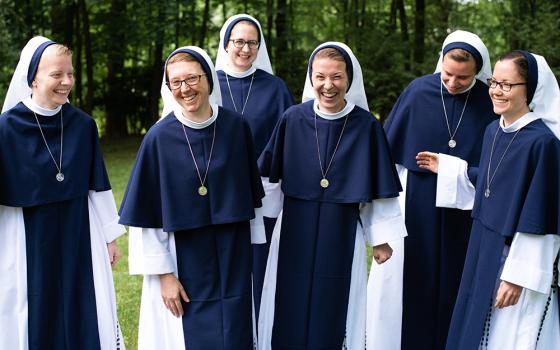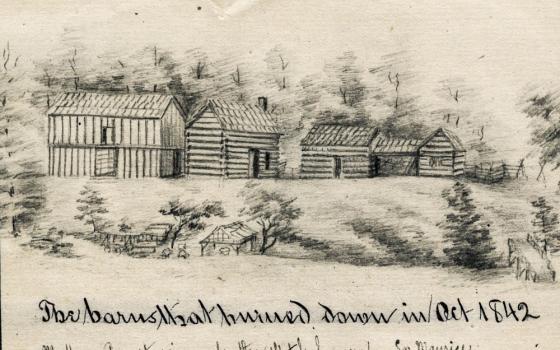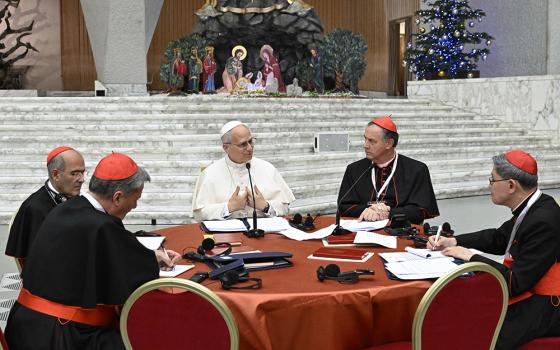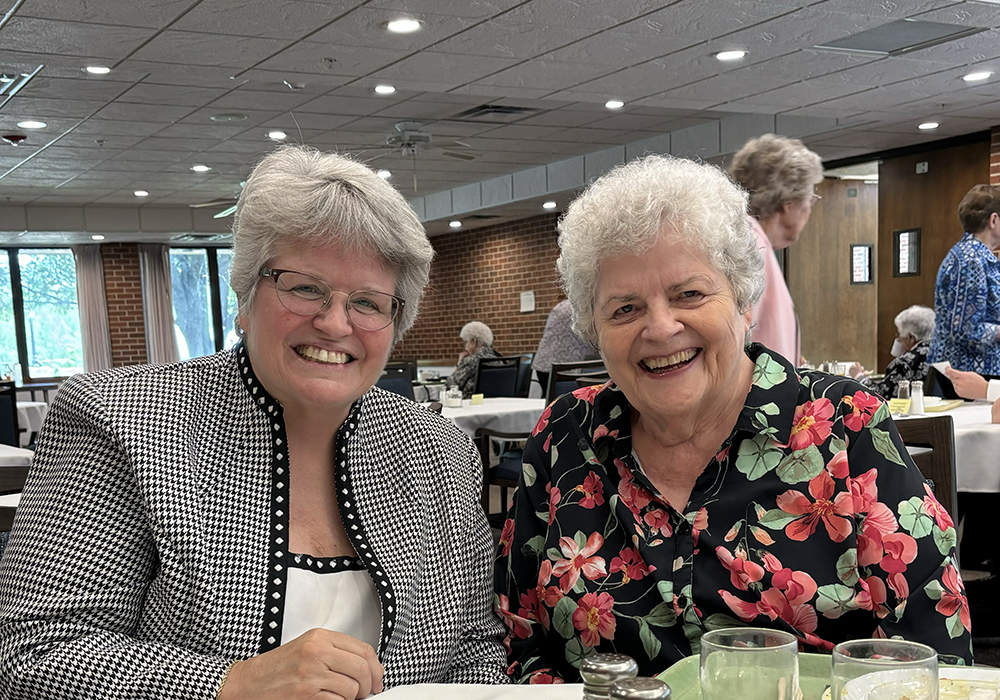
Benedictine Srs. Lynn McKenzie, left, and Esther Fangman right, during McKenzie’s last visit to Fangman’s monastery in Atchison, Kansas, in her official role as president of the Congregation of St. Scholastica, in 2025. Fangman died Aug. 11. (Courtesy of Lynn McKenzie)
When someone we love dies, we find ourselves returning again and again to memories, stories and encounters that reveal who they truly were. In remembering, we also give thanks for their presence in our lives and for the many ways their life rippled outward, shaping communities, institutions, and even the wider church.
Having known Esther Fangman, a Benedictine sister of Mount St. Scholastica in Atchison, Kansas, for over 35 years, I know something of which she was made. In her early years in her Benedictine community, she taught in Catholic schools. Later she studied psychology, earning her M.S. in education (School Psychologist Program) from the University of Dayton and her doctorate of education in counseling from Idaho State University. For more than 40 years she counseled many who turned to her for her wisdom and good compassion.
And she grew in that wisdom every year with every person she met, every encounter she had, with everything that life sent her way. Since her death, tributes have poured in from people whose lives she touched.
Esther was never showy, but quiet, unassuming, funny and loving. She had a way of quietly loving others — her family, her sisters in Atchison, Benedictines in the wider world and so many more. She had a special heart for those who had been sexually abused by those misusing power. She helped many reclaim their self-worth, helping them to love themselves and to have healthy relationships.
She served as president of the Federation of St. Scholastica (now known as the Monastic Congregation of St. Scholastica) for 12 years and led us in life giving ways and through some challenging times. When one of our member monasteries was called out by the Vatican Dicastery for Consecrated Life and an apostolic visitation of their community resulted, Esther accompanied them as sister and president through those years. She taught us that leadership seeks the wisdom of the larger community, that a leader does not have all the answers, and the importance of consulting and finding the wisest way forward together. I followed in her footsteps as the next president.
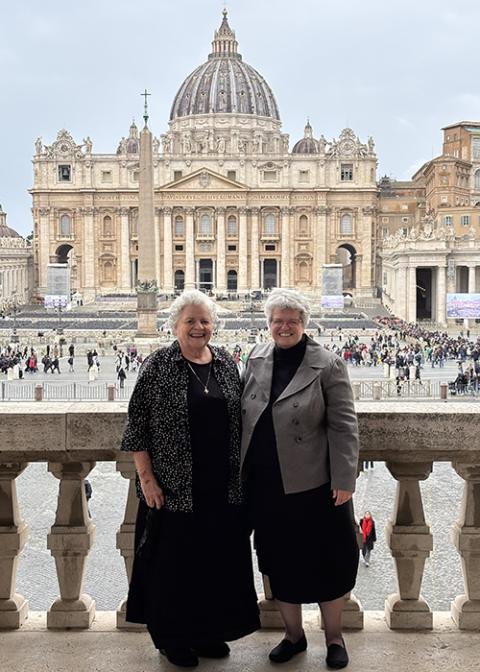
Benedictine Srs. Esther Fangman, left, and Lynn McKenzie stand in front of St Peter’s Square at the Vatican in November 2024 after their visit to the Dicastery for Institutes of Consecrated Life and Societies of Apostolic Life. (Courtesy of Lynn McKenzie)
Also notably, she helped lead all of us Benedictines during the time when all women religious in the United States were summoned by the Vatican’s dicastery for consecrated life, which decreed a nationwide apostolic visitation. She worked with other Benedictine leaders to craft important responses to the Vatican, always seeking to be authentic in our monastic way of life and to help the wider church understand who we are as women Benedictines. She was personally present to our member monasteries as they prepared for on-site visitations by Vatican-appointed women religious. Through those challenges, she guided us with gentleness, and wisdom, being her loving self with her uncanny understanding of human beings and their aspects of darkness and light.
Her influence extended globally. As U.S. delegate to the global association of Benedictine women known as Communio Internationalis Benedictinarum, or CIB, she came to know Benedictines from around the world. Some Benedictines from the African continent, at first confidentially, shared with her their experiences of having suffered sexual abuse at the hands of clergy, bishops and priests alike. These men were taking advantage of the unfair power differential in the church which also came with unequal economic status. The women had to depend on the churchmen for money and other resources for their communities. It too often came at a high price.
Esther, with the permission of those African sisters who had come to her, took these issues to the Vatican, bringing to light this very dark reality.
She was also invited by then-Abbot Primate Notker Wolf of Germany, head of the Benedictine men of the world, to address the worldwide Congress of Abbots in Rome which meets every four years. She was asked to speak about this important topic of Benedictine women suffering the indignity of sexual abuse by clergy, including some Benedictine clergy.
Her message of this cruel and inhumane injustice was well received by many of the Benedictine abbots, but she also was the target of disrespectful behavior by a minority of them. Some walked out as she spoke and one even held up a newspaper high in front of his face and read in protest, an act meant to dismiss this woman who dared to speak to the abbots about such a matter, despite the fact that she had been invited there for that very purpose.
Advertisement
After her years of service as president and as CIB delegate, Esther took a sabbatical, not to rest, but to train in counseling victims of torture. Then she reestablished her counseling practice and volunteered at Keeler Women’s Center in Kansas City, established by her own monastic community of Atchison, and met with those who were victims of torture, working with them to free themselves from the ravages of such inhumanity. She had the heart of a servant who was loving and wise, grounded in expertise, knowledge and compassion.
She had the heart of a servant who was loving and wise, grounded in expertise, knowledge and compassion.
Later, when her own monastic community called her to be prioress, she humbly said yes again, leading them through the worldwide coronavirus pandemic which hit especially hard in communities of women religious with many elderly members. The decisions about Covid protocol, mandatory quarantines, mask-wearing and having to make difficult decisions, took their toll on Esther, but she performed this challenging responsibility with her usual good humor, collaboration, wisdom and compassion.
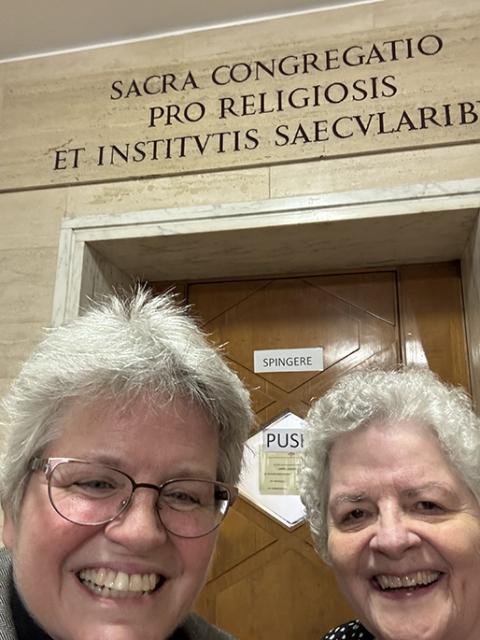
Benedictine Srs. Lynn McKenzie, left, and Esther Fangman stand outside the Sacra Congregatio pro Religiosis et Institutis Saecularibus now called the Dicastery for Institutes of Consecrated Life and Societies of Apostolic Life, to prove they were there on official business, in November 2024. (Courtesy of Lynn McKenzie)
Even after stepping down as prioress, she kept on saying yes. She was often and repeatedly called on by her own prioress and many others in the Benedictine world for her wise counsel. As recently as 9 months ago she agreed to accompany me to a meeting at the Vatican dicastery in Rome about one of our member monasteries. And as recently as 7 months ago she agreed to facilitate a large joint meeting of Benedictine congregation presidents and their councils as we look toward an uncertain future. Yet again she prepared well for this meeting and led us through a process of imagining new collaborative ways to live into the future as Benedictine women.
Over and over again in her good life, Esther said yes to God and her sisters and the church. She humbly offered herself, often at great personal sacrifice, in service to others. Today, as we remember Esther, we do so with gratitude, for her wisdom, her humor, her courage and her fierce commitment to justice and compassion. She showed us that leadership is about presence and that holiness is made up of small, daily yeses to God and community.
Her funeral gathered many of us in Atchison, Kansas, and around the world thanks to livestreaming. Esther Fangman was a Benedictine woman who said yes to the light and darkness, yes to God, yes to her sisters, and yes to the demands of love. And we thank God for the gift of her life.

